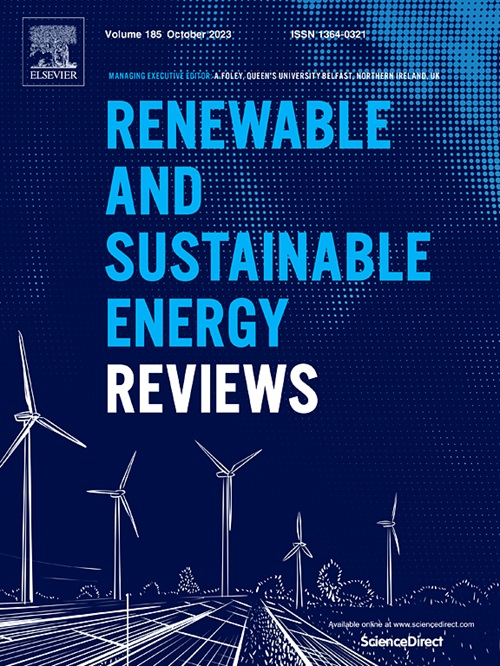Techno-economic analysis of alternative energy sources for icebreakers in the Baltic Sea
IF 16.3
1区 工程技术
Q1 ENERGY & FUELS
引用次数: 0
Abstract
The growing emphasis on sustainability in the maritime industry has sparked significant interest in alternative energy sources, with ambitious goals set to reduce ship emissions. Industry stakeholders have responded with various strategies, such as optimizing existing power plants, improving energy efficiency, and developing innovative power plant designs utilizing alternative fuels. In light of the global pressure to transition to cleaner maritime operations, this study evaluates five sustainable fuel alternatives for icebreakers - LNG, methanol, ammonia, hydrogen, and nuclear energy - in comparison to diesel, with the aim to balance operational power needs, life cycle costs, and increasingly strict environmental regulations. The results indicate that the Small Modular Reactor (SMR) is a highly promising energy source, combining technical feasibility and economic viability, with lifecycle costs 14.9 M€ lower and emissions 80% less than the next best option. A key benefit is its ability to generate electricity profitably, providing additional revenue during off-season periods. Moreover, for the operational profile of icebreakers, methanol and ammonia are emerging as feasible options, enabling a path toward a cleaner future without requiring excessive tank volume. All hydrocarbons can be produced from either fossil-based or renewable carbon sources, offering flexibility for investment in engines that can transition to sustainably produced fuels without requiring engine modifications. This transition can be timed strategically, considering the cost dynamics of sustainable fuels and evolving emissions regulations. This study aims to guide shipowners and designers in making informed decisions by considering operational, functional, economic, environmental, and regulatory factors throughout the ship’s lifecycle.
波罗的海破冰船替代能源的技术经济分析
海运业对可持续性的日益重视引发了对替代能源的极大兴趣,并制定了减少船舶排放的宏伟目标。行业利益相关者已经采取了各种策略,例如优化现有发电厂,提高能源效率,开发利用替代燃料的创新发电厂设计。鉴于向更清洁的海上作业过渡的全球压力,本研究评估了破冰船的五种可持续燃料替代品——液化天然气、甲醇、氨、氢和核能——与柴油相比,旨在平衡运营电力需求、生命周期成本和日益严格的环境法规。结果表明,小型模块化反应堆(SMR)是一种非常有前途的能源,结合了技术可行性和经济可行性,其生命周期成本比次优方案低1490万欧元,排放量减少80%。一个关键的好处是它能够盈利发电,在淡季期间提供额外的收入。此外,对于破冰船的运营情况,甲醇和氨正在成为可行的选择,从而在不需要过多储罐容积的情况下实现更清洁的未来。所有碳氢化合物都可以从化石燃料或可再生碳源中生产,这为发动机投资提供了灵活性,可以在不需要修改发动机的情况下过渡到可持续生产的燃料。考虑到可持续燃料的成本动态和不断发展的排放法规,这种转变可以有战略地把握时机。本研究旨在指导船东和设计师通过考虑船舶整个生命周期中的操作、功能、经济、环境和监管因素,做出明智的决策。
本文章由计算机程序翻译,如有差异,请以英文原文为准。
求助全文
约1分钟内获得全文
求助全文
来源期刊

Renewable and Sustainable Energy Reviews
工程技术-能源与燃料
CiteScore
31.20
自引率
5.70%
发文量
1055
审稿时长
62 days
期刊介绍:
The mission of Renewable and Sustainable Energy Reviews is to disseminate the most compelling and pertinent critical insights in renewable and sustainable energy, fostering collaboration among the research community, private sector, and policy and decision makers. The journal aims to exchange challenges, solutions, innovative concepts, and technologies, contributing to sustainable development, the transition to a low-carbon future, and the attainment of emissions targets outlined by the United Nations Framework Convention on Climate Change.
Renewable and Sustainable Energy Reviews publishes a diverse range of content, including review papers, original research, case studies, and analyses of new technologies, all featuring a substantial review component such as critique, comparison, or analysis. Introducing a distinctive paper type, Expert Insights, the journal presents commissioned mini-reviews authored by field leaders, addressing topics of significant interest. Case studies undergo consideration only if they showcase the work's applicability to other regions or contribute valuable insights to the broader field of renewable and sustainable energy. Notably, a bibliographic or literature review lacking critical analysis is deemed unsuitable for publication.
 求助内容:
求助内容: 应助结果提醒方式:
应助结果提醒方式:


